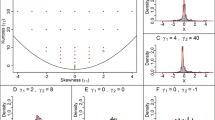Abstract
The validity of a test is often estimated in a nonrandom sample of selected individuals. To accurately estimate the relation between the predictor and the criterion we correct this correlation for range restriction. Unfortunately, this corrected correlation cannot be transformed using Fisher'sZ transformation, and asymptotic tests of hypotheses based on small or moderate samples are not accurate. We developed a Fisherr toZ transformation for the corrected correlation for each of two conditions: (a) the criterion data were missing due to selection on the predictor (the missing data were MAR); and (b) the criterion was missing at random, not due to selection (the missing data were MCAR). The twoZ transformations were evaluated in a computer simulation. The transformations were accurate, and tests of hypotheses and confidence intervals based on the transformations were superior to those that were not based on the transformations.
Similar content being viewed by others
References
Anderson, T. W. (1957). Maximum likelihood estimates for the multivariate normal distribution when some of the observations are missing.Journal of the American Statistical Association, 52, 200–203.
Anderson, T. W. (1984).An introduction to multivariate statistical analysis (2nd ed.), New York, NY: Wiley & Sons.
Bobko, P., & Rieck, A. (1980). Large sample estimates for standard errors of functions of correlation coefficients.Applied Psychological Measurement, 4, 385–398.
Cohen, A. C. (1955). Restriction and selection in samples from bivariate normal distributions.Journal of the American Statistical Association, 50, 884–893.
Cohen, A. C. (1991).Truncated and censored samples: Theory and applications. New York, NY: Marcel Dekker.
Ghiselli, E. E. (1966).The validity of occupational aptitude tests. New York, NY: Wiley.
Gross, A. L. (1990). A maximum likelihood approach to test validation with missing and censored dependent variables.Psychometrika, 3, 533–549.
Heckman, J. J. (1979). Sample selection bias as a specification error.Econometrica, 47, 153–161.
IMSL Library (1987).User's manual stat/library. Houston, TX: Author.
Little, R. J. A., & Rubin, D. B. (1987).Statistical analysis with missing data. New York, NY: John Wiley & Sons.
Lord, F. M., & Novick, M. R. (1968).Statistical theories of mental test scores. Reading, MA: Addison-Wesley.
Pearson, K. (1903). Mathematical contributions to the theory of evolution XI. On the influence of natural selection on the variability and correlation of organs.Philosophical Transactions of the Royal Society, London, Series A, 200, 1–66.
Shohoji, T., Yamashita, Y., & Tarumi, T. (1981). Generalization of Fisher'sz-transformation.Journal of Statistical Planning and Inference, 5, 347–354.
Wolfram, Stephen. (1991).Mathematica: A system for doing mathematics by computers. Reading, MA: Addison-Wesley.
Author information
Authors and Affiliations
Rights and permissions
About this article
Cite this article
Mendoza, J.L. Fisher transformations for correlations corrected for selection and missing data. Psychometrika 58, 601–615 (1993). https://doi.org/10.1007/BF02294830
Received:
Revised:
Issue Date:
DOI: https://doi.org/10.1007/BF02294830




